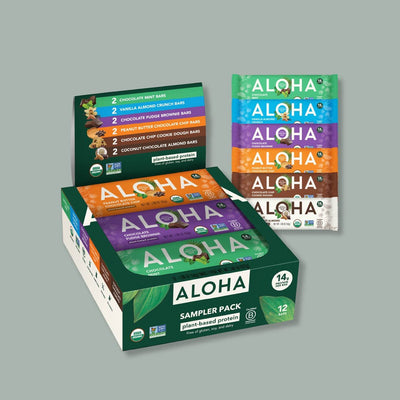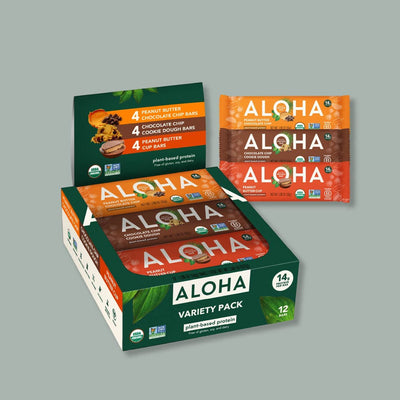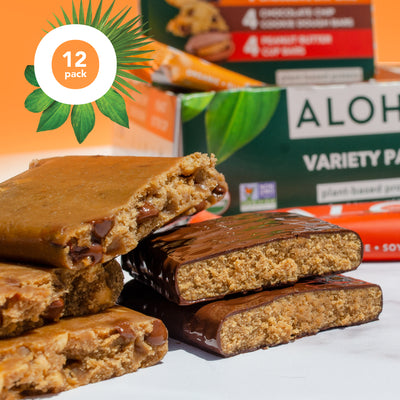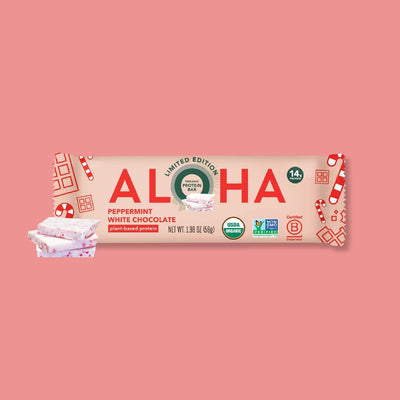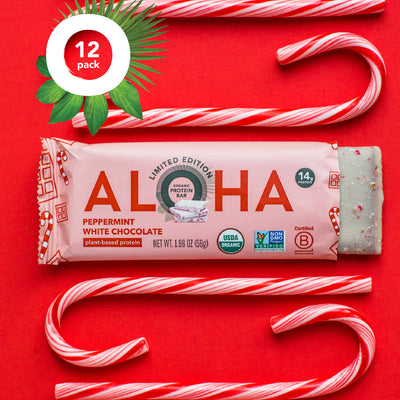Key Takeaways:
- Start With Your Goal: The “best” powder depends on what you value—taste, clean ingredients, digestibility, or how you’ll use it.
- Read The Label: Look for 15–20g protein per serving, short ingredient lists, organic/vegan/Non-GMO certifications, and soy-free if that matters to you.
-
Taste Matters: Texture and flavor are make-or-break. Choose brands known for smooth mixability and great taste so you’ll actually use them every day.
If you’re just getting started and asking what is the best vegan protein powder, the right answer is the one you’ll use consistently. At ALOHA, we craft soy-free, USDA Organic, Non-GMO Project Verified, Certified Vegan powders that blend velvety smooth, made by an employee-owned, Certified B Corp/PBC that prioritizes people and planet.
Below, we’ll show you how to evaluate ingredients, flavor, certifications, and use cases so you can pick a powder that fits your routine and tastes amazing.
Vegan Protein Powder 101
Vegan protein powders are made from plants—think peas, brown rice, pumpkin seed, hemp, and blends that combine sources for a fuller amino profile. They’re easy to add to smoothies, oats, and even baked goods, helping you distribute protein across the day. If you’re brand new to plant-forward eating, this primer on what is a plant-based diet is a friendly place to start.
What Is The Best Vegan Protein Powder? Here’s How To Decide
Start by defining what “best” means for you, then reverse-engineer the label. If you want everyday convenience, look for a powder that delivers about 15–20g protein per scoop with a short, recognizable ingredient list and third-party standards you care about (USDA Organic, Non-GMO Project Verified, Certified Vegan). If you prefer soy-free or lower-sweetness options, filter for those explicitly. Blends (for example, pea + rice + pumpkin seed) can improve amino balance and mouthfeel, while single-source powders may suit specific preferences. Scan sodium, fiber, and sweetener types, and consider brand values like sustainability and transparency if those matter to you.
Next, pressure-test taste and texture in the exact ways you’ll use it. For shake people, blend with your usual plant milk, a handful of frozen fruit, and give it 20–30 extra seconds for max smoothness. For bowl people, whisk into warm oats or yogurt-style bases to check mixability and flavor. If you’re sensitive to new ingredients, begin with half a scoop and build up. The right pick is the one you’ll reach for daily—creamy, versatile, and aligned with your goals and routine.
Ingredients & Quality
Short, recognizable ingredient lists are a good sign. Many people prefer organic, Non-GMO, and Certified Vegan powders; if you avoid soy, choose explicitly soy-free formulas. Blends (e.g., pea + rice + pumpkin) can balance taste and texture while supporting a complementary amino profile.
Protein Per Scoop & Aminos
Aim for about 15–20g of protein per serving, adjusting for your size and activity. Blends help round out lysine and methionine, while add-ins like chia or hemp can give a small extra bump. For a plain-English refresher on why distribution matters, see all about protein.
Sweeteners, Flavors, And Additives
If you like classic flavors (vanilla, chocolate), pick options with natural flavors and minimal sweeteners. Unsweetened versions are great for savory uses or DIY sweetness with fruit. Check sodium and fiber levels if you’re sensitive.
Certifications & Transparency
Prioritize powders with clear third-party standards—USDA Organic, Non-GMO Project Verified, Certified Vegan, and brands that share sourcing values. As a Certified B Corp/PBC, ALOHA centers transparency, community, and environmental stewardship.
Taste, Texture & Mixability
If you’re wondering what is the best tasting vegan protein powder, texture is half the battle. Choose brands known for creamy mouthfeel and easy mixing; for flavor comparisons, this roundup of the best tasting protein powder can help you narrow picks you’ll actually crave.
Types Of Vegan Protein Powders (And When To Use Them)
Think of each plant protein as a tool for a specific job, and the “best” choice depends on how you’ll use it. Pea is creamy and neutral, great for shakes and everyday mixing; brown rice is lighter and mixes cleanly, especially useful in baking; pumpkin seed and hemp bring a subtle, nutty flavor that shines in oatmeal, energy bites, and savory sauces.
Blends combine these strengths for smoother texture and more balanced use across smoothies, bowls, and batters, often the easiest answer to what is the best vegan protein powder for daily routines. If taste tops your list for what is the best tasting vegan protein powder, start with a vanilla or chocolate blend, then test it in the exact format you love (smoothie vs. warm oats). Unsweetened options are perfect when you want full control over sweetness and seasoning.
Pea
Pea protein is the workhorse of many plant powders because it’s creamy, neutral, and blends beautifully. If you’re testing what is the best vegan protein powder for daily shakes, pea delivers a smooth, drinkable texture without gritty afterfeel, and it disappears easily into pancakes, muffins, and waffles. It also plays nicely with spices, cocoa, and fruit, which makes dialing in what is the best tasting vegan protein powder much simpler. For most beginners, pea is an easy, versatile starting point.
Brown Rice
Brown rice protein brings a light flavor and ultra-clean mixability, making it great for warm oats, smoothies, and baking where you don’t want the powder to dominate. On its own it’s mild; paired with pea, it helps balance amino gaps so your scoop performs more like a complete protein. If your priority is subtle taste and seamless blending, brown rice is a reliable option that keeps recipes flexible. Many “unflavored” fans prefer rice for maximum control.
Pumpkin Seed & Hemp
Pumpkin seed and hemp proteins add a gentle, nutty character that shines in oatmeal, energy bites, granola bars, and savory sauces. Hemp also contributes plant-based omega-3s, while both options integrate well with seeds, nuts, and spices for layered flavor. If you’re chasing variety or want your powder to double as a pantry ingredient, these bring personality without overpowering a recipe. They’re great picks when you want a little flavor lift alongside solid protein.
Blends
Blended powders (for example, pea + rice + pumpkin) combine strengths: smoother texture, rounder flavor, and more balanced amino coverage. That’s why blends are often the simplest answer to what is the best vegan protein powder for everyday use—and frequently contenders for what is the best tasting vegan protein powder as well. They tend to shine in quick shakes with just plant milk and ice but also fold into bowls and batters without chalkiness. If you want one tub to do it all, start with a well-made blend.
Curious how plant proteins stack up with dairy formulas for cooking and shakes? Here’s a clear comparison of plant-based protein vs whey to help you choose.
Match Your Powder To Your Goal
Picking what is the best vegan protein powder gets easier when you map it to how you’ll use it. If you’re chasing convenience, pick a blend that’s delicious with just plant milk and ice. If you love bowls and baking, an unsweetened or vanilla powder disappears into oats, pancakes, and sauces. For a deeper decision tree, read how to choose the best protein powder for your goals.
The Benefits Of Vegan Protein Powder (At A Glance)
Vegan powders can help you hit your protein target with fewer ingredients and lots of flexibility such as smoothies, oatmeal, baked goods, and more. They support a plant-forward routine and can align with values around sourcing and environmental impact. Learn more in benefits of vegan protein powder.
Make It Delicious: Flavor Tips That Actually Work
Great taste turns a good habit into a lasting one—and answers what is the best tasting vegan protein powder for you personally. Blend 20–30 seconds longer than you think for an ultra-smooth shake, use frozen fruit for body, and add a creamy boost with a spoon of nut butter or a quarter avocado. A pinch of salt, cinnamon, cocoa, or espresso powder makes flavors pop; for bowls, whisk powder into warm oats or yogurt-style bases so it dissolves completely.
ALOHA’s Promise: Soy-Free, Organic, And Employee-Owned
ALOHA powders are soy-free, USDA Organic, Non-GMO Project Verified, and Certified Vegan; our ready-to-drink options are Fair Trade Certified. As an employee-owned company and Certified B Corp/PBC, we prioritize governance, workers, customers, community, and the environment—so choosing your powder can reflect your values as much as your taste buds.
Final Thoughts
The “best” pick isn’t universal—it’s the powder that fits your routine and tastes great day after day. Start with your goals, scan the label for clean ingredients and certifications, and pressure-test the flavor with your favorite smoothie or oatmeal. When your powder is delicious and easy to use, keeping protein consistent becomes effortless.
Read Also:
- Clean Protein Power 101: All Your Questions Answered
- Fresh Protein Bars Explained: ALOHA’s Secrets Revealed
- Is Whey A Complete Protein? Your Burning Questions Answered
Frequently Asked Questions About Vegan Protein Powder
What makes one vegan protein powder “best” for me?
Your best pick matches your goals, taste preferences, and how you’ll use it. Look for 15–20g protein per serving, simple ingredients, and certifications you value. If you prefer soy-free or organic, filter by those first. Then test mixability and flavor in your favorite shake or bowl.
Is a blend better than a single-source powder?
Blends often deliver a smoother texture and more balanced amino profile, which many people find easier to enjoy daily. Single-source powders can be great for specific needs or flavor preferences. Try both and see what your palate—and your recipes—prefer. The right choice is the one you’ll use consistently.
How do I make my shakes taste better without extra sugar?
Start with frozen fruit for body, add a creamy element like nut butter, and blend longer for a silky finish. A pinch of salt or warm spices (cinnamon, cocoa) brightens flavor fast. If you like café vibes, try espresso powder or vanilla. Texture upgrades often reduce the urge for added sweeteners.
Are vegan powders good for baking and cooking?
Yes. Vanilla or unflavored powders fold into pancakes, waffles, muffins, energy bites, and even sauces. Start by swapping 10–20% of the flour with powder and adjust liquid to maintain batter consistency. This approach adds protein without overpowering flavor.
How much protein should I aim for per serving?
Most people do well with about 15–20 grams per serving, adjusting for body size and activity level. Focus on distributing protein across the day rather than relying on one big hit. If you want a refresher on daily totals and timing, the “all about protein” article linked above is helpful. Consistency beats perfection.
Can I meet my needs without soy?
Absolutely. Pea, rice, pumpkin seed, hemp, and blends make it easy to stay soy-free while hitting your target. Combine sources over the day—meals plus a shake—to keep things simple. If you’re planning a fully plant-based routine, see how to get protein on a vegan diet for practical food lists and portions.
How do plant proteins compare to whey?
Plant proteins can be just as convenient and versatile, with differences in flavor and texture you may actually prefer. Many people choose plant-based for sourcing, allergens, or dietary preferences. For a clear, side-by-side breakdown, read plant-based protein vs whey. Pick what aligns with your goals and tastes.
What certifications should I look for?
USDA Organic, Non-GMO Project Verified, and Certified Vegan are common trust signals. If sustainability matters to you, look for brands with transparent sourcing and third-party standards. ALOHA’s employee-owned, Certified B Corp/PBC status reflects a broader commitment to governance, community, and environment.
Will vegan protein upset my stomach?
Many people find plant-based powders comfortable, especially blends with smooth textures and modest fiber. If you’re sensitive, start with half a serving and build up, and test flavors to see what sits best. Hydration and blending thoroughly can also improve digestibility.
What’s the easiest way to pick a powder today?
Decide your top priority—taste, clean label, or versatility—then shortlist two options that fit. Make one smoothie and one oatmeal bowl with each to test flavor and mixability. If you want a guided framework, skim how to choose the best protein powder for your goals and you’ll have a confident answer to what is the best vegan protein powder in a single read.





